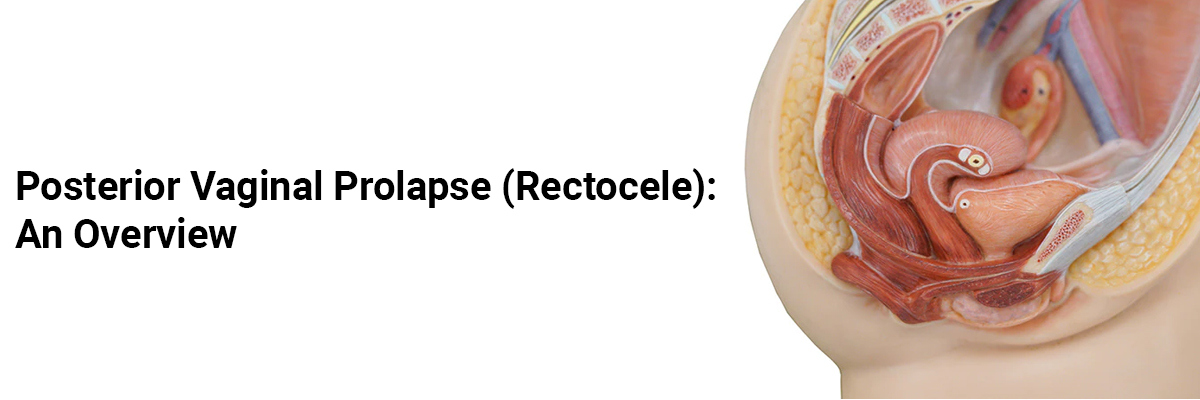
 IJCP Editorial Team
IJCP Editorial Team
Posterior Vaginal Prolapse (Rectocele): An Overview
The rectum is the colon's last part (large intestine). Both rectum and vagina stay in position because the muscles and ligaments in the pelvis form the pelvic floor and hold them in place. When the pelvic floor weakens, these organs can shift and even fall onto each other.
Rectocele or posterior vaginal wall prolapsed
Rectocele is a form of pelvic organ prolapse (POP), where organs sag because of a weak pelvic floor. Rectocele often occurs with other forms of pelvic organ prolapse, where organs like the uterus or bladder are also affected.
A rectocele weakens the tissues in the pelvis to cause the rectum to sag onto the vaginal wall. One may not notice symptoms if the bulge (prolapse) is small. The rectum may protrude out of the vagina with a more significant prolapse. Severe cases may demand surgery to repair the rectocele.
Sign and Symptoms
Rectoceles may not always lead to visible symptoms. However, they can cause discomfort or uneasiness rather than physical pain if present. Signs of a rectocele may be felt in the rectum or vagina.
Symptoms of a rectocele in the rectum
• Inability to empty the bowels
• Constipation
• A feeling of stool stuck
• frequent bowel movements
• straining for bowel movement
• Incontinence
• A need for vaginal splinting (putting pressure in the vagina with the fingers) to have a bowel movement
• Pain in the rectum
• Feeling that the rectum hasn't completely emptied after pooping.
Symptoms of a rectocele in the vagina
• A lump in the vagina
• A feeling of fullness in the vagina
• Tissue extending outside the vagina
• Vaginal bleeding
• A sensation of loss of vaginal muscle tone
When presented with another form of prolapse where the bladder sags, rectocele may also cause urinary incontinence, with the urge to pee frequently or dribble.
Causes and Risk Factors triggering rectocele
Rectoceles are more common in women as they age. They are caused by pressure on the pelvic floor, which can happen for various reasons. Several factors that contribute to the occurrence of Rectoceles are:
• Pregnancy and childbirth: Vaginal childbirth can damage or weaken the pelvic floor, especially during multiple births. Prolonged labor and large newborns can stretch the pelvic floor muscles, weakening the support for the vagina.
• Aging: The pelvic floor can weaken over time. Menopause brings many changes in the body, leading to decreased muscle tone in the pelvic region.
• Chronic cough or bronchitis: Long coughing due to asthma, smoking, and respiratory disease may pull the pelvic floor muscles, making them prone to rectocele.
• Chronic constipation: Straining too hard to poop can weaken the pelvic muscles.
• Repeated heavy lifting: Frequent heavy lifting can strain pelvic floor muscles too much, causing them to stretch and weaken.
• A heavier body: obesity may increase the risk of rectocele.
• Previous surgery: Surgeries involving pelvic organs (such as hysterectomy) may damage the tissue in the pelvic floor.
Diagnosis and Analysis tests
Rectocele is diagnosed with a thorough medical history and physical examination. The tests include-
• The pelvic exam includes examining the vaginal canal for signs of prolapse; the provider may test pelvic floor strength during the exam. They may ask to squeeze and relax the pelvic floor muscles simulating stopping a pee stream. They may also request to apply pressure to the gut or strain, simulating pooping and making prolapse more visible.
• Imaging: Imaging isn't usually necessary for rectocele diagnosis. In rare instances, the provider may order a transvaginal ultrasound to check the prolapse of the small intestine (enterocele). The healthcare provider may also prescribe a special X-ray called a defecography which shows the changes in the rectum while pooping and can detect the severity of the rectocele.
Treatment
Mild rectoceles demand pelvic floor exercises to strengthen pelvic floor muscles. A vaginal pessary, a removable device inserted into the vagina to support prolapsed organs, may also be used. Moderate to more severe prolapse may need surgery to repair the rectocele, which depends on-
• One's age and general health.
• The degree of prolapse.
• A desire for future pregnancies.
• Willingness to continue having intercourse (since surgery for POP called colpocleisis seals the vaginal opening).
The commonly employed surgical procedure is posterior colporrhaphy which removes damaged tissue that no longer supports the pelvic organs and sutures the healthy tissue together for added support.
Often, rectocele surgeries are performed through the vagina to leave no scars.
Prevention
Good practices can help strengthen the pelvic floor and reduce the risk of prolapse, such as:
• Perform Kegel exercises regularly. Kegel's are essential after childbirth as they can strengthen the pelvic floor muscles.
• Treat and prevent constipation. Consume plenty of fluids and high-fiber foods, like fruits, vegetables, beans, and whole-grain cereals. Use stool softeners if needed.
• Avoid heavy lifting and lift correctly. Maintain correct posture and distribute weight while lifting heavy objects. Put pressure on the legs instead of the waist or back when lifting.
• Manage a cough. Get treatment for a chronic cough, and quit smoking.
• Maintain a healthy weight. Follow weight-loss strategies if needed.
Prognosis
The prognosis or outcome depends on the symptoms and severity of the prolapse. Most people undergoing surgery for rectocele experience symptom relief soon after.
The bottom line
The diagnosis of a rectocele may make many people anxious. In some cases, it might be a relief to find out the reason for the symptoms and to know that effective treatments are available. A physical therapist can help to strengthen the pelvic floor muscle and cope with a rectocele via exercises. In some cases, pelvic floor therapy and dietary changes may also be helpful.

IJCP Editorial Team
Comprising seasoned professionals and experts from the medical field, the IJCP editorial team is dedicated to delivering timely and accurate content and thriving to provide attention-grabbing information for the readers. What sets them apart are their diverse expertise, spanning academia, research, and clinical practice, and their dedication to upholding the highest standards of quality and integrity. With a wealth of experience and a commitment to excellence, the IJCP editorial team strives to provide valuable perspectives, the latest trends, and in-depth analyses across various medical domains, all in a way that keeps you interested and engaged.









.png)




Please login to comment on this article